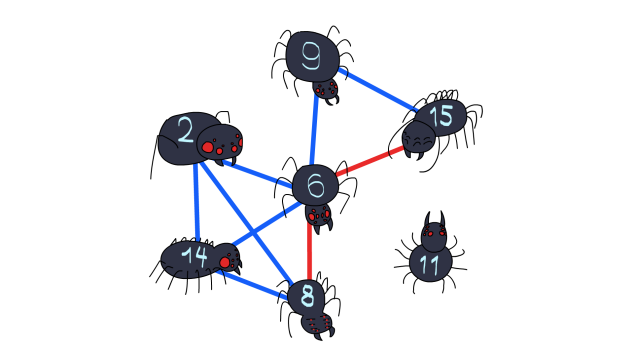CF1775D.Friendly Spiders
普及/提高-
通过率:0%
AC君温馨提醒
该题目为【codeforces】题库的题目,您提交的代码将被提交至codeforces进行远程评测,并由ACGO抓取测评结果后进行展示。由于远程测评的测评机由其他平台提供,我们无法保证该服务的稳定性,若提交后无反应,请等待一段时间后再进行重试。
题目描述
Mars is home to an unusual species of spiders — Binary spiders.
Right now, Martian scientists are observing a colony of n spiders, the i -th of which has ai legs.
Some of the spiders are friends with each other. Namely, the i -th and j -th spiders are friends if gcd(ai,aj)=1 , i. e., there is some integer k≥2 such that ai and aj are simultaneously divided by k without a remainder. Here gcd(x,y) denotes the greatest common divisor (GCD) of integers x and y .
Scientists have discovered that spiders can send messages. If two spiders are friends, then they can transmit a message directly in one second. Otherwise, the spider must pass the message to his friend, who in turn must pass the message to his friend, and so on until the message reaches the recipient.
Let's look at an example.
Suppose a spider with eight legs wants to send a message to a spider with 15 legs. He can't do it directly, because gcd(8,15)=1 . But he can send a message through the spider with six legs because gcd(8,6)=2 and gcd(6,15)=3 . Thus, the message will arrive in two seconds.
Right now, scientists are observing how the s -th spider wants to send a message to the t -th spider. The researchers have a hypothesis that spiders always transmit messages optimally. For this reason, scientists would need a program that could calculate the minimum time to send a message and also deduce one of the optimal routes.

输入格式
The first line of input contains an integer n ( 2≤n≤3⋅105 ) — the number of spiders in the colony.
The second line of input contains n integers a1,a2,…,an ( 1≤ai≤3⋅105 ) — the number of legs the spiders have.
The third line of input contains two integers s and t ( 1≤s,t≤n ) —the spiders between which the message must be sent.
输出格式
If it is impossible to transmit a message between the given pair of spiders, print −1 .
Otherwise, in the first line of the output print the integer t ( t≥1 ) — the number of spiders that participate in the message transmission (i. e. the minimum time of message delivery in seconds plus one). In the second line, print t different integers b1,b2,…,bt ( 1≤bi≤n ) — the ids of the spiders through which the message should follow, in order from sender to receiver.
If there are several optimal routes for the message, output any of them.
输入输出样例
输入#1
7 2 14 9 6 8 15 11 5 6
输出#1
3 5 4 6
输入#2
7 2 14 9 6 8 15 11 5 7
输出#2
-1
输入#3
7 2 14 9 6 8 15 11 5 5
输出#3
1 5
说明/提示
The first example is shown above. It shows that the message from the 5 -th spider (with eight legs) to the 6 -th spider (with 15 legs) is optimal to pass through the 4 -th spider (with six legs).
In the second example, the spider number 7 (with 11 legs) is not friends with anyone, so it is impossible to send him a message.